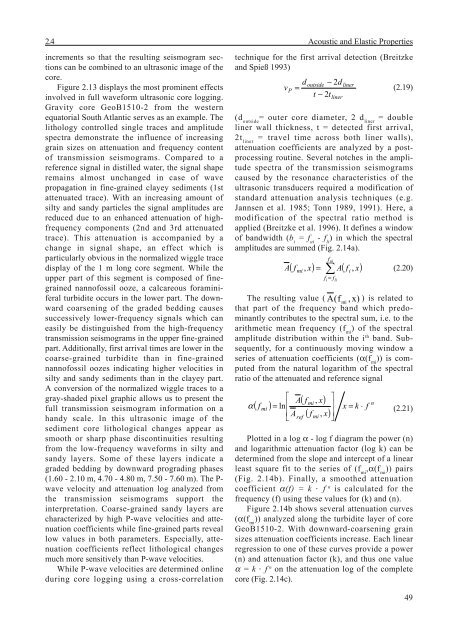2 Physical Properties of Marine Sediments - Blogs Unpad
2 Physical Properties of Marine Sediments - Blogs Unpad
2 Physical Properties of Marine Sediments - Blogs Unpad
You also want an ePaper? Increase the reach of your titles
YUMPU automatically turns print PDFs into web optimized ePapers that Google loves.
2.4 Acoustic and Elastic <strong>Properties</strong>increments so that the resulting seismogram sectionscan be combined to an ultrasonic image <strong>of</strong> thecore.Figure 2.13 displays the most prominent effectsinvolved in full waveform ultrasonic core logging.Gravity core GeoB1510-2 from the westernequatorial South Atlantic serves as an example. Thelithology controlled single traces and amplitudespectra demonstrate the influence <strong>of</strong> increasinggrain sizes on attenuation and frequency content<strong>of</strong> transmission seismograms. Compared to areference signal in distilled water, the signal shaperemains almost unchanged in case <strong>of</strong> wavepropagation in fine-grained clayey sediments (1stattenuated trace). With an increasing amount <strong>of</strong>silty and sandy particles the signal amplitudes arereduced due to an enhanced attenuation <strong>of</strong> highfrequencycomponents (2nd and 3rd attenuatedtrace). This attenuation is accompanied by achange in signal shape, an effect which isparticularly obvious in the normalized wiggle tracedisplay <strong>of</strong> the 1 m long core segment. While theupper part <strong>of</strong> this segment is composed <strong>of</strong> finegrainednann<strong>of</strong>ossil ooze, a calcareous foraminiferalturbidite occurs in the lower part. The downwardcoarsening <strong>of</strong> the graded bedding causessuccessively lower-frequency signals which caneasily be distinguished from the high-frequencytransmission seismograms in the upper fine-grainedpart. Additionally, first arrival times are lower in thecoarse-grained turbidite than in fine-grainednann<strong>of</strong>ossil oozes indicating higher velocities insilty and sandy sediments than in the clayey part.A conversion <strong>of</strong> the normalized wiggle traces to agray-shaded pixel graphic allows us to present thefull transmission seismogram information on ahandy scale. In this ultrasonic image <strong>of</strong> thesediment core lithological changes appear assmooth or sharp phase discontinuities resultingfrom the low-frequency waveforms in silty andsandy layers. Some <strong>of</strong> these layers indicate agraded bedding by downward prograding phases(1.60 - 2.10 m, 4.70 - 4.80 m, 7.50 - 7.60 m). The P-wave velocity and attenuation log analyzed fromthe transmission seismograms support theinterpretation. Coarse-grained sandy layers arecharacterized by high P-wave velocities and attenuationcoefficients while fine-grained parts reveallow values in both parameters. Especially, attenuationcoefficients reflect lithological changesmuch more sensitively than P-wave velocities.While P-wave velocities are determined onlineduring core logging using a cross-correlationtechnique for the first arrival detection (Breitzkeand Spieß 1993)vPd outside − 2dliner= (2.19)t − 2tliner(d outside= outer core diameter, 2 d liner= doubleliner wall thickness, t = detected first arrival,2t liner= travel time across both liner walls),attenuation coefficients are analyzed by a postprocessingroutine. Several notches in the amplitudespectra <strong>of</strong> the transmission seismogramscaused by the resonance characteristics <strong>of</strong> theultrasonic transducers required a modification <strong>of</strong>standard attenuation analysis techniques (e.g.Jannsen et al. 1985; Tonn 1989, 1991). Here, amodification <strong>of</strong> the spectral ratio method isapplied (Breitzke et al. 1996). It defines a window<strong>of</strong> bandwidth (b i= f ui- f li) in which the spectralamplitudes are summed (Fig. 2.14a).∑( f x) A( f x)mifA , , (2.20)= ui fi= fliThe resulting value ( Af (mi, x)) is related tothat part <strong>of</strong> the frequency band which predominantlycontributes to the spectral sum, i.e. to thearithmetic mean frequency (f mi) <strong>of</strong> the spectralamplitude distribution within the i th band. Subsequently,for a continuously moving window aseries <strong>of</strong> attenuation coefficients (α(f mi)) is computedfrom the natural logarithm <strong>of</strong> the spectralratio <strong>of</strong> the attenuated and reference signal( f )⎡⎢⎣A( f mi , x)( f , x)⎤⎥⎦nα mi = lnx = k ⋅ f (2.21)⎢ Arefmi⎥Plotted in a log α - log f diagram the power (n)and logarithmic attenuation factor (log k) can bedetermined from the slope and intercept <strong>of</strong> a linearleast square fit to the series <strong>of</strong> (f mi,α(f mi)) pairs(Fig. 2.14b). Finally, a smoothed attenuationcoefficient α(f) = k ⋅ f n is calculated for thefrequency (f) using these values for (k) and (n).Figure 2.14b shows several attenuation curves(α(f mi)) analyzed along the turbidite layer <strong>of</strong> coreGeoB1510-2. With downward-coarsening grainsizes attenuation coefficients increase. Each linearregression to one <strong>of</strong> these curves provide a power(n) and attenuation factor (k), and thus one valueα = k ⋅ f n on the attenuation log <strong>of</strong> the completecore (Fig. 2.14c).i49
















